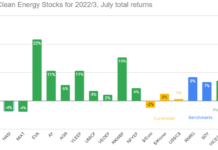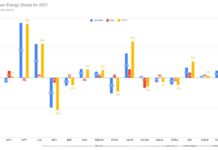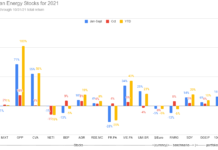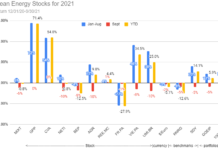What Constitutes an Alternative Energy Company?
There’s a debate going on in the clean energy investment community about which companies are "green" enough to merit our attention. Before the filming of my WealthTrack appearance, I got into a discussion with Ardour Global Indexes’ Joseph LaCorte. The Global Alternative Energy ETF (NYSE: GEX) is based on the index he manages.
The format of the show includes a top pick from each of the guests at the end of the show, and Mr. LaCorte was hoping that I’d pick GEX, since I had previously told him that it was my favorite alternative energy ETF. However, my pick was General Electric (NYSE: GE), because they have a substantial presence in many alternative energy sectors and are attractively priced. GE does not fit Ardour Indexes screen as an alternative energy company because only about 6% of their earnings (his number) come from alternative energy.
Coven v. Coven
Another index manager, Raphael Coven, Managing Partner of the Cleantech Index, made roughly the same point on my Give the Gift of a Green Future article. He said,
Are [GE and Sharp’s] cleantech businesses (very good ones) are sufficiently large to significantly affect their earnings and hence stock prices? Certainly not in the case of GE and probably not in Sharp’s case either.
Yet in an interview on EnergyTechStocks, he says that
He is “particularly bullish” on companies involved in making electric power grids more efficient, and thus he likes Siemens, ABB and General Electric, each of which he thinks could do very well fixing the woebegone grids in the U.S., China and elsewhere in the world.
I couldn’t agree more.. Siemens (NYSE:SI) and The ABB Group (NYSE:ABB) are also among my top picks for the same reasons he outlines, although of them are particularly pure clean energy businesses. Part of our difference of opinion may be that I see fixing and improving the grid as essential to the future of clean energy, while he may be thinking of it as an end in itself.
Indexes v. Portfolios
I don’t think Raphael Coven has a multiple personality disorder. Rather I believe he was speaking about different things at different times. The two index managers and I agree that GE shouldn’t be in a clean energy index. There’s too much to the company other than clean energy. However, the question of whether GE should be in a green portfolio is an entirely different matter from its inclusion in an index. From our conversation, I don’t know if Mr. LaCorte agrees on this point, but Mr. Coven most likely does from his comments above.
Put another way, it would be irresponsible from the standpoint of portfolio management to put an entire portfolio into a narrow sector such as alternative energy. For instance, a portfolio composed solely of GEX would be up about 30% since GEX started trading last May, but if it had started trading at the start of 2008 (or, more realistically, an investor decided to reallocate his entire portfolio to GEX as the market opened on January 2. I say "he" because men are much more likely to choose aggressive portfolios than women.)
The hypothetical investor who bought GEX on Jan 2 would have already lost 12% of his money (or $12,000 out of a $100,000 investment) two weeks later, compared to only 3.6% if they’d put their money in the broad S&P. Very few investors have the emotional conviction to ride out that kind of quick decline without acting (usually exactly when their holdings are at their lows.)
Clean Energy Earnings: The Lessons of Green P/E
Companies like GE allow a diversified investor to buy into excellent clean energy businesses, such as GE Wind, roof-integrated solar tiles, and their LED lighting business at cost multiples far lower than the lofty multiples of pure-play counterparts, if those companies have earnings at all. Per Yahoo!, GE’s P/E is 16.9. Using Joseph LaCorte’s 6% number as the percent of GE’s business that’s in alternative energy, we find that you have to buy $282 of GE stock to get $1 of earnings for alternative energy. I’ll call this GE’s "Green P/E."
A 282 Green P/E sounds high, until you start looking at the alternatives. The world’s top wind company, Vestas, has a P/E of 107, First Solar (NASD: FSLR) last year’s solar high-flyer has a P/E of 161, and the top pure-play LED company, Cree (NASD:CREE) has a P/E of 36. This gives us an average P/E of these three about 101.
An investor who wanted to buy $1 of clean energy earnings from GE would have to invest $181 (= $282-$101) more than an investor buying an equal-weighted portfolio of the three companies listed above. For that $181, he would get $15.68 of other (non-alternative energy) earnings, so he would have essentially invested in a well-run non-green business with a P/E of 11.5, something which is basically impossible to find in today’s market.
Put another way, either GE’s green businesses are currently under-priced relative to leading pure-play companies, or the rest of the company is selling for peanuts. Either way, GE seems like a great relative value play.
That is why it’s in almost every portfolio I manage.
DISCLOSURE: Tom Konrad and/or his clients have long positions in GE, SHCAY, ABB, SI, CREE, and a short position in FSLR.
DISCLAIMER: The information and trades provided here and in the comments are for informational purposes only and are not a solicitation to buy or sell any of these securities. Investing involves substantial risk and you should evaluate your own risk levels before you make any investment. Past results are not an indication of future performance. Please take the time to read the full disclaimer here.








Nice article.
“Green energy” is a big topic and there are many many points to discuss. But quickly…
Some of the alternative energy plays such as GEX recognize the proven technology and know-how built in some already up-and-running business models that work (such as Vestas). There is a tail wind blowing in favor of these companies. More likely than not over the long run (and some of us are willing to ride through volatility) these companies by-and-large as a group (or sector) should prove themselves for the following reasons. The fundamentals are there and in the long run fundamentals are fundamentals – there is an underlying law of physics at play here. The world needs more energy and the best way to get incremental increases in energy relatively independent of the volatilty of the commodity markets is alternative energy sources – wind and solar are at the top the list. Nuclear is not incremental at all – having all sorts of massive up front costs. Also, key patents are held by some of these wind turbine companies. Complementing this several of them offer a “solution” approach – with a total implementation capability to realistically develop an enterprise solution with little re-engineering required. Over time more vertical integration will take place which will stimulate M&A activity. I will eventually own Siemans and GE through acquistion activity by the GEs of the world buying the Vestas of the world out. This may take several years but I am willing to wait this out. Oil will price itself into obsolescence as will coal. Utilities worldwide are buying out already established wind farms for obvious reasons – they are competitive sources of power generation – they represent a threat. The regulated and limited distribution markets prevent more independent producers from entering the electric generation markets (for the time being). The scalability of production and demand curves will provide for a force for continued growth in wind and solar. This is the next dot com era for investment, excitement and innovation. There will be losers and there will be major winners. Taking a history lesson from the dot com era many smaller start-ups failed but come sailed with quite a tail wind. It is unlikely that GE or SI will double or triple in the next 18 months. The companies held within GEX have this potential – especially if China, US and India start spending on electric power generation to grow and develop their electric generation capacity into the new energy paradigm which is glowing green. As an individual investor I am buying into GEX on the dips and today was a good day to buy.
I agree, you’re not going to get a double with GE in the next year or so… but I think GE’s alternative energy businesses are every bit as good or better than the pureplay companies.
On the other hand, if you’re looking for doubles, you might want to take a look at my 10 Speculations for 2008.
Another point to keep in mind is that even if you are a shareholder of an aquired company, you may not end up owning shares in the aquirer. A case in point is AstroPower, a solar manufacturer I bought and sold in 1999 at a small (30%, if I recall) profit, but which went bankrupt a year or so later, and ended up being aquired by GE. If I had not sold, I would have lost my entire investment, because the money from GE’s purchase was used to pay creditors and bondholders, not shareholders.